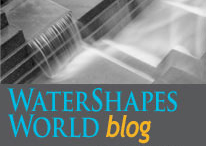watershaping
I’ve spent considerable time in recent days chatting with watershapers about the way things are going — just touching base with old friends, mostly. These conversations generally start with curiosity about
To excel as professionals, watershapers need to develop a good working knowledge of a range of technical disciplines – hydraulics, materials science and geology, for example – and know the ins and outs of structural, electrical and mechanical engineering. No single person needs to have certified expertise in all of those fields, but it’s becoming increasingly clear that anyone who enters the watershaping realm needs to be conversant in the mix of disciplines he or she must coordinate if the goal of
Eric Herman has served as the editor of WaterShapes magazine since its inception in 1999. During a career spanning more than 25 years, he has written and edited articles across a broad range of industries, technical subjects and business interests. According to
In his book Gardening with Water, James van Sweden called water “the heart of the garden.” I’ve had the privilege of working with him and his partner, Wolfgang Oehme, since 1986, and all of us at Oehme, van Sweden & Associates (Washington, D.C.) share an appreciation for the simple profundity of our founding partner’s words that is clearly reflected in the way we use water. To be sure, we occasionally design gardens without water, but more often it’s a key part of what we do and serves as a powerful foil to plants, hardscape, art and architecture. We enthusiastically take advantage of the way it brings contrasts, reflections and sounds to spaces and exploit its ability to define destinations, invite recreation or provide gathering spaces. We also work closely with all of the psychological associations it conjures within human beings – feelings of tranquility or excitement as well as sensations of the raw, regenerative power of nature. In our work, which spans the full spectrum of residential, commercial, public and institutional settings, fully 80 percent include watershapes in some form, from lily ponds, rills or cascades to formal fountains or swimming pools. Occasionally these are stand-alone features, but when the situation permits, we’ll use them in
Many great artists are best known for working in identifiable genres, styles or modes or with specific materials, themes or some other defining detail. From Picasso’s cubist abstractions to Mozart’s cascading melodies or Rodin’s bronzes to Frank Gehry’s sweeping architectural forms, geniuses of all stripes are in one way or another known for qualities that are distinctly theirs. The same holds true for many watershapers, especially those working at the top of the field. While many of us (myself included) cross the lines that divide distinctive modes, styles and genres, even the most free-spirited among us can be
I've written several times in the past about the fact that more and more landscape architects and designers are getting into watershaping. As evidence, all you need to do is look at design-award competitions in the pool and spa industry and note the increasing number of submissions from landscape professionals: It's even getting to the point in some programs where they're outnumbering participants who come from the traditional pool and spa industry. You'll find even more evidence of this phenomenon on the web sites of landscape-focused companies, where you'll see watershapes of all shapes and descriptions in most of their photo galleries. Moreover, many I know in the pool and spa industry have had the experience of



















Green Horizons